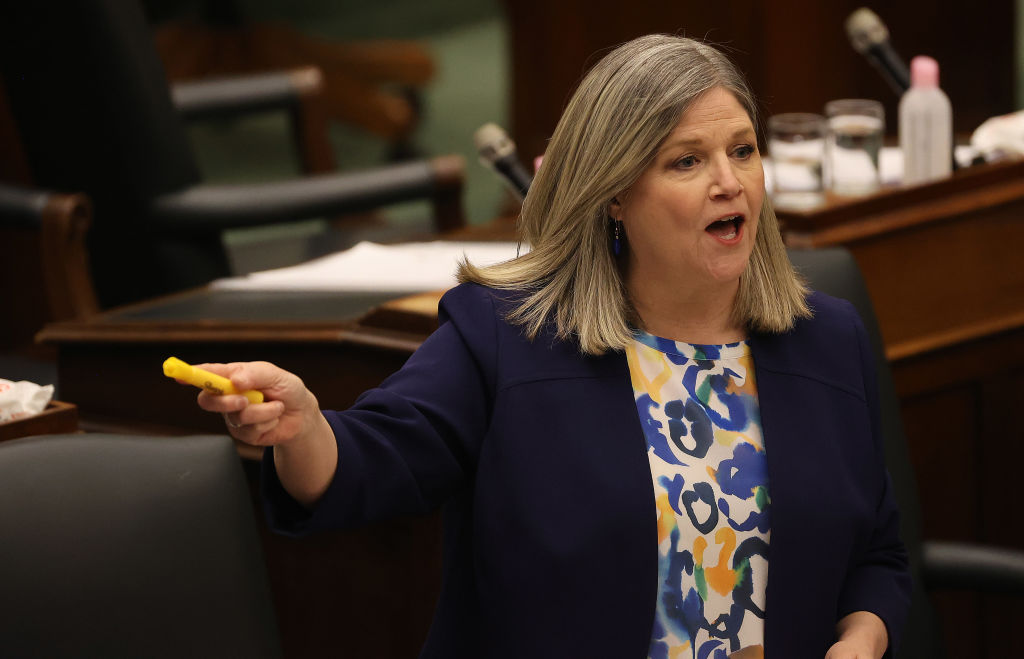More needs to be done by the province to address the massive backlog of surgeries and procedures delayed as a result of the COVID-19 pandemic, Ontario NDP Leader Andrea Horwath said Wednesday.

Horwath held a virtual news conference outside of St. Joseph’s Hospital in London, Ont., where she called on Premier Doug Ford and the province to implement an urgent and fully-funded action plan, and to allocate more funding in the budget toward tackling the issue.
“We know that there are literally hundreds of thousands of surgeries that have been delayed. People who are in a situation where their conditions may have worsened. Worried about when they’re finally going to get the surgeries that they need,” said Horwath, who was joined by local MPPs Teresa Armstrong, Terence Kernaghan, and Peggy Sattler.
“Doug Ford needs to invest the money necessary to clear the backlogs so that people know exactly when it is that they’ll get that call and know that their procedure or their surgery is being booked.”
Last month, the Financial Accountability Office projected Ontario’s surgery backlog would reach 419,200 procedures by the end of September and would take approximately three and a half years to clear. Factoring in postponed diagnostic procedures, the tally rises to nearly 2.5 million.
The province’s fiscal watchdog has estimated it would cost $1.3 billion to clear the backlog, nearly $700 million more than what the Ontario government allocated in its latest budget to address the issue.
In London-Middlesex alone, London Health Sciences Centre estimates that it faces a backlog of several thousand procedures accumulated during the pandemic.
In an interview with 980 CFPL on April 9, during the peak of the third wave, LHSC’s chief medical officer, Dr. Adam Dukelow, estimated the organization’s surgical capacity was down about 5,000 at the high end “if you compare the COVID year versus the year previous.”
During a media briefing in mid-May, Dukelow noted that returning to normal operations could take several months, “and years to recover from the amount of backlog of activity.”
“We have a government that has ignored the the crisis. They put a budget together that short changes the procedures and surgery requirements to get those backlogged patients given the health care that they deserve,” Horwath said.

Ontario hospitals were given the go ahead last month to resume non-urgent surgeries, however some including London Health Sciences Centre are still not back up to normal capacity.
Hospitals in the province were ordered in late April to curb non-emergent and non-urgent surgeries and procedures during a significant surge in cases and hospitalizations. Hospitals also transferred patients between facilities and staff were redeployed to handle a surge in cases.
As of this week, 14 of 17 operating rooms at London’s Victoria Hospital and 11 out of the 15 at University Hospital have come back online, said Carol Young-Ritchie, LHSC’s executive vice-president, chief clinical officer and chief nursing officer, during Monday’s COVID-19 briefing.
“Our occupancy today — we’d like it to be around 90 per cent — it’s at 95 per cent, and appreciating that we are trying to do as much of our backlog volume as we can,” Young-Ritchie said.
“Certainly we do prioritize the cases that we do, emergent and urgent certainly taking priority, and then looking at what other cases we can put through, again given some of our constraints with the outbreak,” she said, referencing the ongoing outbreak in University Hospital’s eighth-floor transplant unit.
The outbreak, declared earlier this month, has only added to the backlog issue, with the temporary postponement of some scheduled procedures at the hospital.
To manage the outbreak, LHSC has closed some inpatient beds at University Hospital and has transferred some patients to Victoria Hospital, where 12 additional beds have been opened.
On Wednesday, the province unveiled a $30 million Surgical Innovation Fund as part of roughly $300 million it says was allocated in the budget to help the hospital sector recover from the pandemic.
The proposal-based funding will support all Ontario hospitals “address barriers to surgeries that cannot be addressed by other existing hospital funding streams,” according to a provincial release.
Proposals must be submitted by July 21 for review, with funding expected to be released in the early fall.
In the release, the province touted several initiatives it says it has implemented to help the hospital sector, including funding supports for weekend and evening surgeries, having publicly funded surgical and diagnostic imaging be delivered in alternate settings, as well as unspecified “investments in improving surgical efficiency and output.”
“Despite the significant impacts of the COVID-19 pandemic on inpatient capacity, Ontario hospitals were able to complete on average 88 per cent of their targeted surgical allocations this past year,” the release states, adding that the province has invested $5.1 billion in the hospital sector during the pandemic, including an additional $1.8 billion in the recent budget.
980 CFPL reached out to the Ministry of Health for comment but did not receive a response by publishing time.




Comments